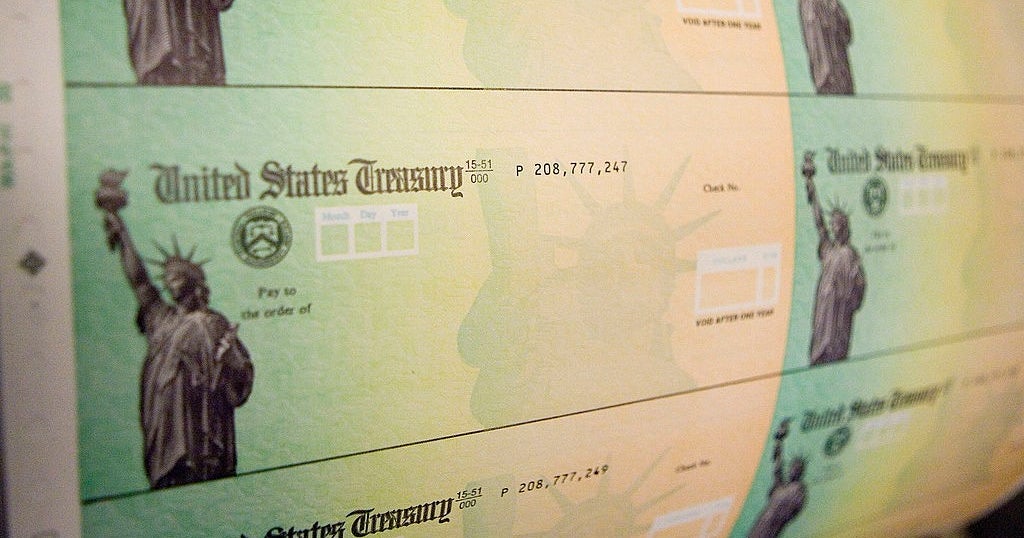Child Tax Credit 2021: Here's when the sixth check will deposit
The sixth — and potentially final — payment from the Child Tax Credit program is set to hit U.S. parents' bank accounts on Wednesday. Unless lawmakers renew the benefit, parents of 61 million children won't receive additional monthly checks in 2022.
The sixth payment will be deposited directly into the bank accounts of millions of parents on December 15, although some families may receive the check through the mail, which could add several days to the delivery time.
The enhanced Child Tax Credit, which was expanded through President Joe Biden's American Rescue Plan, is credited with lifting millions of children out of poverty through the monthly cash payments, which anti-poverty advocates say have helped families afford basics like food, rent and educational expenses. But the future of the benefit remains in limbo as Congress debates the Build Back Better Act, which would include a one-year extension of the monthly payments.
The CTC "takes a swipe at rural poverty," said Whitney Kimball Coe, director of national programs at the Center for Rural Strategies. The payments "aren't a paycheck, not a living wage — they are a bridge to hope, to a good night's sleep, so families don't have to choose between food and keeping the lights on."
She added, "My community can't afford to lose its bridge."
Monthly checks so far have been issued on or around the 15th of each month. The Build Back Better Act must be passed by December 28th for payments to continue on schedule and land in accounts by January 15, the IRS has told some lawmakers.
Since the checks began in July, the IRS has sent more than 200 million payments totaling more than $93 billion, the agency said on Wednesday.
Here's what to know about the sixth CTC check.
When does the Child Tax Credit arrive in December?
The fifth payment date is Wednesday, December 15, with the IRS sending most of the checks via direct deposit. For most families, the agency relies on bank account information provided through individual tax returns or via its Non-filer tool, which is aimed at people who don't normally file tax returns.
The bank deposit will be labeled "CHILDCTC."
How much will I receive in the December CTC payment?
As with previous checks, eligible families with children under age 6 will receive $300 per child, while those with children ages 6 to 17 will receive $250 per child.
Eligibility is largely based on income, given that lawmakers wanted to target the payments to low- and middle-income families. To receive the full payments, single taxpayers must earn less than $95,000, while joint filers must earn less than $170,000. Payments are reduced if taxpayers earn above that amount.
Some parents who signed up more recently for the checks could see a bigger lump sum, such as if they missed the prior months' payments and registered for the payments before the November 15 cutoff to receive a payment before the end of the year.
What if I didn't get any payments?
The IRS says that eligible families who didn't get any CTC payments can claim the full amount on their 2021 federal tax return.
For families with children under 6, the full amount of the CTC is $3,600 per child. Families with children between 6 to 17 can claim the full amount of $3,000 per child if they didn't get any monthly payments.
What happens to the CTC after December?
Without the passage of the Build Back Better Act, the monthly checks will cease after December 15.
Even so, the enhanced CTC still has a benefit that parents can claim on their 2021 taxes before the April 15, 2022 filing deadline. That's because the expanded CTC divided the benefit between monthly checks, issued starting in July and ending in December, with the other half to be claimed on tax returns.
Under the enhanced CTC, families with children under 6 received a $3,600 tax credit in 2021— with $1,800 of that sent via the monthly checks, or $300 per month. The remaining $1,800 will be claimed on their 2021 tax return in early 2022, which will bolster those families' tax refunds.
Families with children between 6 to 17 receive a $3,000 tax credit. Of that, $1,500 was sent via the monthly checks, or $250 per month. They'll also be able to claim the remaining tax credit — $1,500 — on their tax returns next year.
Without an extension of the expanded CTC, the tax credit will revert to its pre-2021 form. Under those guidelines, the CTC will shrink to $2,000 per child starting in 2022 and won't include monthly checks. Parents will claim the tax credit on their tax return once per year.
The pre-2021 CTC also has some income restrictions that mean very low-income families typically aren't able to receive all or some of the benefit. That's because the older CTC requires families to have a tax liability in order to receive the benefit — something that many poor families don't have.
Will I owe taxes on the CTC payments?
No, because the IRS says the payments aren't considered income. They "are advance payments of your tax year 2021 Child Tax Credit," according to the IRS website.
However, there is a snag that could cause a headache for some taxpayers.
The IRS based a family's eligibility on its most recent tax return, which for most people is their 2020 filing. Millions of people lost income and jobs that year due to the pandemic, but many regained their financial footing in 2021. If that happened and their income rose above the income cutoffs that determine eligibility, they may have received the full CTC payments — yet not actually have been qualified for them.
In that case, they'll have to repay the IRS for the overpayments when they file their 2021 tax returns early next year.
What happens when I file my taxes?
The IRS says it will send Letter 6419 in January to taxpayers who received the CTC payments. The tax agency is asking people to keep the letter and refer to it when they file their 2021 tax return to make sure the amount they received is correctly reflected on their filing.
Even though the IRS says getting the CTC payments won't delay your tax refund, there is the potential for errors that could hold up your return at the tax agency. For instance, if you mistakenly say that you received advance payments of $1,500 but actually received $1,800, the IRS will note the discrepancy with its records and potentially flag the return for review.
Such snags contributed to the 35 million tax returns that were held up at the IRS earlier this year, delaying tax refunds for millions. To be sure, some of the delay was caused by staffing issues related to the pandemic, but some taxpayers incorrectly reported the amount they received from the stimulus payments — causing their returns to get flagged for review.
Basically, to ensure that your tax return is swiftly processed early next year, it's important to check your Letter 6419 and include the correct payment amount on your return.



